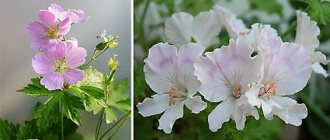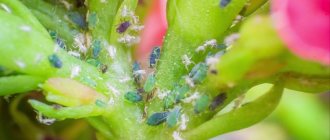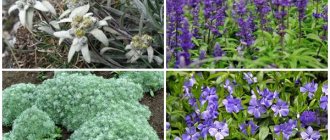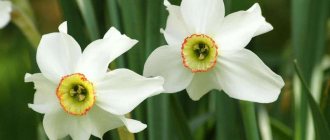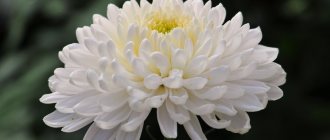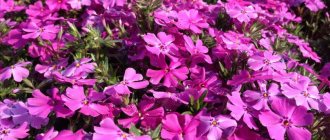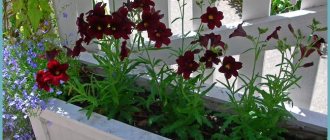- 3.1 Sowing seedlings
Pompon aster is one of the types of garden asters. According to the new classification of plants, they are assigned to the genus Callistephus of the Asteraceae family. The correct name is “Callistephus chinensis”. This crop is annual or biennial, grows in Eurasian countries, and originally appeared in China. More than two hundred varieties of such asters, bred before the beginning of 2021, differ from each other in the height of the bushes, the structure and shape of the flowers, as well as the rainbow color of the petals. The pompom aster can be identified by its uniquely formed flower - it is a hemisphere of densely growing petals collected in a rosette, resembling a pom-pom of a child's hat.
Why is it recommended to sow seeds?
The fruit of the pompon aster is a cone-shaped seed pod containing seeds of different sizes. Aster seeds are quite large and easy to work with. They are also frost-resistant. If you sow them directly into a flower bed, the seedlings will be stronger than seedlings. In addition, asters grown in open ground can withstand short-term light frosts. And for especially valuable varieties you can always find a place in a greenhouse or on a windowsill.
Landing dates
Pompon asters can be grown by seedlings or by sowing seeds in open ground. The second method is suitable only for the southern regions. In this case, the seeds are sown directly into the flowerbed.
General guidelines for deadlines, taking into account regions
Dates for planting asters using the seedling method:
| Region | Sowing seeds for seedlings | Transplantation into the ground |
| Middle zone and Moscow region | Beginning and mid-April | Second half of May |
| South | End of March - beginning of April | Beginning of May |
| Leningrad region, Ural, Siberia | End of April - beginning of May | The beginning of June |
The best dates for sowing aster seeds according to the lunar calendar:
| Month | Favorable days on the waxing moon |
| March | 19, 20 |
| April | 6, 7, 8, 11, 12, 13, 15, 16, 17 |
| May | 8, 9, 10 |
The best dates for transplanting seedlings into the ground according to the lunar calendar:
| Month | Favorable days |
| May | 1, 7, 8, 9, 10, 13, 14, 15, 16, 17, 18, 26, 27, 28 |
| June | 5, 6, 9, 10, 11, 12, 12, 14, 15 |
The most popular varieties with photos
- Princess Mix.
How to sow: step-by-step instructions
This type of flower has a long growing season: flowering of early varieties begins 3 months after sowing, late varieties - after 4 months. Therefore, asters prefer to be grown in seedlings. On the other hand, when growing pom-pom asters from seeds, sowing directly into the ground eliminates a lot of worries and hassle. When sown before winter, the seeds undergo stratification under natural conditions. Plants grow stronger. When sowing in spring, stratification helps to increase seed germination and survival rate.
Seedling method
Growing with seedlings is a more labor-intensive method than without seedlings, but it is more reliable and gives good results in terms of germination and survival.
Seeds for seedlings are sown in boxes with loose plant substrate or directly into the soil of the greenhouse.
Before planting, the seeds can be stratified: wrapped in a damp cloth and placed in the refrigerator overnight. and keep it warm during the day. Repeat this for a week. After the sprouts appear, the seeds can be sown.
Instructions for planting asters for seedlings:
- Germination. 7 days before planting, the seeds are soaked in a weak solution of potassium permanganate for 2 hours, washed and placed in a warm place on a damp cloth.
- Soil preparation. Fertile soil, peat and sand are mixed in proportions 1:1:1. The soil turns out to be light and loose.
- Soil disinfection. The soil must be disinfected with a solution of fungicide or potassium permanganate.
- Make grooves 2 cm deep in the soil, carefully place the hatched seeds and sprinkle with sand.
- After planting, the seeds are watered with a weak solution of potassium permanganate through a sieve or sprayed with a spray bottle.
- The earth is covered with a thin transparent film and placed in a moderately warm place with a temperature of up to +22°C.
As soon as the shoots appear (usually on the 4th–5th day), the film is removed and the boxes are moved to a brighter and cooler place. Optimum temperature +16°C.
Growing seedlings and transplanting into open ground
The seedlings need regular moderate watering and preventive treatment against blackleg with a solution of potassium permanganate after one watering. The soil should not be over-moistened.
When 3-4 true leaves appear, it’s time to pick. At this point, the central root should be shortened by a third. The seedlings are transplanted into a large box, pots or greenhouse soil. When planting in boxes and directly in the greenhouse, maintain a distance of 5–7 cm between plants. Seedlings of pom-pom asters tolerate replanting well.
The first feeding is carried out a week after picking the plants. For example, it could be potassium humate and nitrophoska, taken 1 tsp each. for 2 liters of water. Next, the seedlings need to be fed every week until planting in open ground.
If it is warm outside, seedlings can be hardened off before planting. Every day, the time the seedlings spend outdoors should be increased slightly, starting with half an hour.
Asters love light and do not tolerate stagnant water, so you should choose a bright and as level place for them as possible so that the water does not stagnate when watering and after rain.
Aster seedlings are planted in the ground at the age of about one and a half months. Before planting, you should make sure that the plants have 8 leaves, a well-developed root system, the stem is strong, and its length is 10 cm or more. Planting is carried out in the evening; the grooves should be prepared in advance and filled with water.
The gaps between grooves are 50 cm, between flowers - 15–25–35 cm, depending on the size of the flowers of an adult plant and the height of its stem.
Instructions for transplanting seedlings to a permanent place:
- Weed the selected flower bed.
- Loosen the soil to a depth of 6 cm.
- Water seedlings in pots or boxes.
- Make holes or grooves in the flowerbed according to the size of the seedling containers.
- Water the soil.
- Transplant the seedlings to the prepared place.
- Cover with dry soil. No need to water.
- After 10 days, add nitrogen-containing fertilizers to the holes.
2–9 weeks after planting, fertilize with complex fertilizer, the next time fertilize after 4 weeks.
Sowing seeds in open ground and caring for seedlings
Pompon asters can be planted in winter, while the seeding rate is increased by ⅓ compared to spring and the freshest seeds with high sowing qualities, stored for no more than 2 years, are selected.
For 2 weeks, the seeds are soaked in a solution of potassium permanganate of medium concentration and then thoroughly dried. Before winter, the planting depth is reduced by 2 times, that is, the depth of the furrows will be 2 cm. With the onset of persistent cold weather, dry seeds in dry weather are sown in pre-prepared furrows, and the soil should already be frozen. Then the grooves are mulched with peat to prevent the formation of a crust after the melt water has drained. The thickness of the peat layer is 3 cm.
If planting is carried out in the spring:
- In pre-prepared soil, grooves up to 4 cm deep are marked at a distance of 0.5 m from each other and seeds are planted in them.
- Then sprinkle with soil and water. At night, the plantings are covered with film. to protect against night frosts. The film is removed after germination and returned only if there is a possibility of a sudden cold snap.
Seedling
This method, although more troublesome than the seedless method, is, however, more reliable and gives an almost guaranteed positive result in the form of good seedlings and plant survival.
It is necessary to plant seeds for seedlings already in February-March: in this case, fully formed, strong seedlings will be ready by May.
A week before planting the seeds in the ground, wrap them in a wet natural cloth soaked in a solution of potassium permanganate. Keep the seeds in this tissue for 10-12 hours - this way they will be provided with stratification, which will support the plant’s fight against diseases in the future.
Be sure to pre-treat the soil in the seedling box with a fungicidal solution. Sprinkle the seeds with fine sand on top and pour a weak solution of potassium permanganate through a strainer. To grow healthy aster seedlings, fill the box with loose, nutritious substrate. After the seeds are in the ground, cover the box with a thin, light-transmitting film and place it in a warm place.
As soon as the sprouts appear, remove the film and move the box itself to a cooler place. Sprouts require regular, but not excessive watering.
Picking sprouts should be done when they already have 3-4 leaves. When picking, shorten the roots of the sprouts slightly. The dug up seedlings can either be thrown out or transplanted into another container.
A week after picking, feed the asters with complex mineral fertilizer, and before planting in open ground, carry out such feeding weekly.
When it gets warmer outside, take the boxes with seedlings outside in the sun, thus accustoming the plants to their future permanent habitat and hardening them.
By the time of planting in open ground, the seedlings should have 6-8 leaves and a strong stem 10 cm tall. Experienced gardeners recommend planting pompom aster seedlings in the ground in the evening. The optimal period for this in the middle zone is the end of May. But you can see how to plant Lupine seeds for seedlings in this video.
Pompom aster: growing from seeds, when to plant
Pompon aster is one of the types of garden asters. According to the new classification of plants, they are assigned to the genus Callistephus of the Asteraceae family. The correct name is “Callistephus chinensis”. This crop is annual or biennial, grows in Eurasian countries, and originally appeared in China. More than two hundred varieties of such asters, bred before the beginning of 2021, differ from each other in the height of the bushes, the structure and shape of the flowers, as well as the rainbow color of the petals. The pompom aster can be identified by its uniquely formed flower - it is a hemisphere of densely growing petals collected in a rosette, resembling a pom-pom of a child's hat.
Description
All plants are made up of the same parts: roots, stems, leaves, flowers and fruits. A botanical description of flowers allows you to find out what distinctive shapes, sizes and colors characterize each part of the crop. Pompom aster also has its own varietal characteristics:
- The roots of the pompom aster are widely branched, fibrous, superficial, with a depth of no more than 25 cm, and can quickly recover from damage.
- The stems are erect, strong, have longitudinal grooves, covered with thin small hairs, their color is light green or with a pink tint (depending on the variety). The height of the plant varies from 20 to 90 cm; many shoots are formed on the stem, which is why the bush becomes thick and lush.
- The leaves of the pompom aster are dark green, rich in color; small leaves are located in the upper part of the stem, large ones are closer to the ground.
- Flowers are basket inflorescences, along the outer circle of which there are reed-shaped petals arranged in several tiers; the inner circle is filled with thin tube petals that stand straight, tightly pressed to each other. The color of flowers is determined by the variety; in some cases, mixes of the same variety are created, but in a wide variety of colors. Their diameter is from 4 to 8 centimeters.
- The fruit of the pompom aster is a cone-shaped seed capsule that stores seeds of different sizes, it depends on the variety of aster.
- The crop reproduces, like all annual plants, only by seeds.
In the fall, the seed pods open, the seeds fall into the ground, overwinter well and germinate again in the spring. In this case, the pompom aster blooms early; you only need to thin out the bushes occasionally.
Varieties
If the rose is called the queen of the garden, then the pompom aster is a little princess who loves to dress up in a wide variety of “dresses.” The coloring of her clothes resembles a rainbow palette, including many shades of primary colors. We offer you photos and descriptions of some varieties of pompom aster.
"Winter cherry"
Coloring - the outer petals-tubes of the pompom aster are colored light burgundy, in the center they are snow-white. The petals grow densely, each of them opens in the form of five-lobed bells, which makes the flower cap seem even more magnificent.
The height of the compact aster bush reaches 60 cm; many flower stalks are formed on straight, slightly leafy stems. About 25 ovaries are formed during the season; for their continuous formation, it is necessary to remove the already wilted ones so as not to slow down the process of the appearance of new flowers.
The diameter of one aster flower is up to 8 cm, sometimes more. The flowering period begins in July and can last until autumn frosts. At this time, many plants are already preparing for winter, and the Winter Cherry aster still decorates and enlivens the boring autumn landscape of the garden with its appearance.
Planting aster in open ground begins in April. Further care consists of performing normal work: loosening the soil, removing weeds, watering and fertilizing. Do not forget also about the timely cutting of old dried inflorescences.
Winter cherry aster flowers are used for cutting and arranging autumn bouquets. In the photo you see a typical specimen of this variety of asters.
"Yellow"
The color of the flower is yellow, but not monochrome. The reed petals of the pompom aster are pale yellow at the edges, closer to the center, turning into tube petals, they become rich yellow, and in the center they are almost orange. Reed petals are arranged in several tiers.
The height of the Pompon Yellow aster bush is 40-55 cm, the flower sizes are small (up to 4 cm in diameter), the branching of the stems is average. During the growing season, the shrub forms up to 35 inflorescences. Flowering begins in July and lasts until frost. Planting in the ground is scheduled for the middle or end of May. Grown from seeds.
Flowers of this aster are good for cutting for making monochromatic bouquets or arranging compositions in combination with other representatives of the floral world.
"Princess Diana"
Snow-white delicate flowers adorn the aster bushes of this variety. It is believed that it was named after the beloved English princess. They are simple and charming, just like the most famous woman in the world.
The bush of the plant reaches 80 cm in height, branches strongly, the leaves grow densely, creating additional volume. Aster flowers are pompom-shaped, multi-tiered petals are white at the edges, slightly touched with yellow in the center.
The diameter of the flowers of a similar aster is 11 cm; one bush is capable of forming up to 27 flower ovaries per flowering season. Seeds for seedlings are sown in March or April. The aster blooms in early June, the flowering period lasts a long time, until the end of October.
Princess Diana pompom aster flowers are used to decorate the middle tier of flower arrangements in the garden landscape. Bouquets of cut snow-white aster flowers can be used to decorate wedding processions and banquet halls. With their color, they support the main color of the wedding - pure white, immaculate.
"Princess mix"
From the photo located at the bottom of this paragraph, you can determine that several varieties of Princess asters are collected in a mix. Seed producers often offer such mixtures, calling the mixtures by different names, but the essence is the same - flower growers receive many flowers of different shades. Some people think this is advisable, because in a plot (flower bed) you can grow plants of different colors at the same time and not bother with separate plantings, others like the monochrome nature of flower beds.
Popular varieties of peony aster
Below we will talk about the most popular varieties of peony asters that are grown in Russia.
Aster peony "White Tower"
The blooming buds of the White Tower variety have a uniform petal color - boiling white. The size of the shoots is about 0.7 m, the diameter of the flowers is more than 9 cm.
Astra "American Branch"
These asters are the most popular among Russian flower growers. The color of the petals of the blooming lush large buds of “American Branch” is reddish or pale blue.
Shoot height is up to 0.65-0.7 m.
Aster peony "King size"
This variety of peony-like asters received this name for the huge size of the blooming flowers - up to 15 cm in diameter with a shoot height of more than 0.8 m.
There are several colors of the "King Size" variety, the most popular of which are blue.
Astra "Pink Tower"
For flowers of this variety, the characteristic color of the petals is pale pink with a yellow core. The length of the shoots is more than 60 cm. The “Pink Tower” variety is perfect for cutting.
Peony asters "Gray Lady"
The main characteristic feature of this variety is that the tips of the dark pink or lilac-blue petals are painted silver (gray-haired) in color.
The flowers of the Gray Lady flowers are large, double or semi-double, and can be 9.5-12.5 cm in diameter.
Astra "Red Tower"
This variety is intended for cutting,
shoots grow up to 0.7 m in height. The diameter of the blooming buds of the “Red Tower” is about 9-9.5 cm, the color of the petals is carmine. The flowers are double, flowering continues from the first ten days of July until the onset of cold weather.
Asters "Purple Tower"
As the name of the variety suggests, the color of the large buds that bloom is deep purple. The flowers are lush and bloom until the first cold weather.
Peony aster "Chinese"
Chinese aster is a variety of garden asters.
which includes a large number of different varieties, differing in shoot height - from dwarf to tall.
Asters "Annushka"
These asters grow up to 0.6 m in height. The blooming buds are soft carmine in color, large – up to 0 cm in diameter, terry. The variety "Annushka" is suitable for cutting.
Variety of peony aster “Blue Lagoon”
This variety belongs to the dwarf peony-like asters, the height of the shoots is no more than 0.5 m.
The color of the petals of the blooming buds of the Blue Lagoon aster can be as follows:
- blue;
- blue-violet.
Peony aster "Versailles"
This variety is long-flowering with a shoot height of about 0.6-0.65 m.
The flowers are large, densely double, each diameter is about 9 cm; up to 7-9 peduncles can form on one Versailles aster plant.
Aster variety "Mashenka"
This variety is distinguished by the soft yellow color of its large double buds. The height of the peduncles is up to 0.65-0.7 m. 10-12 peduncles can be formed on each bush. Mashenka can be grown for cutting.
Aster peony "Duchess"
The “Duchess” variety belongs to the mix category (with different colors of petals).
The height of the shoots is up to 0.6 m, the diameter of double flowers is about 9-11 cm.
Astra "Yellow Tower"
The bright yellow single-color buds of this variety look great in flower beds and are also used by florists in flower arrangements.
The diameter of double flowers of the “Yellow Tower” variety is more than 9.5 cm.
Aster peony “Duchess mix (mixture)”
This variety is distinguished by the fact that a large number of side stems extend from the central shoot, each of which produces buds.
Therefore, each such escape is already a whole bouquet. The color of Duchess aster flowers can be varied.
Growing from seeds
Flower growers who constantly grow asters in their gardens use the self-sowing method, when the plant independently sheds its seeds in the fall, and in the spring they germinate again and again. For those who have decided to plant pompom asters for the first time, we recommend that you familiarize yourself with the procedure for propagating them by seed.
Sowing seedlings
Plants of the Asteraceae family have a long growing season before flowering. You can ensure that asters in the garden bloom earlier, and therefore bloom longer, by planting ready-made seedlings in early spring. In this case, sowing of aster seeds begins in January or February (at room temperature). The seedlings will be ready for transplanting into the ground in May-April. You should proceed as follows:
- Preparing pompom aster seeds. Aster seeds are medium in size and easy to handle when sowing. Soak them in 100 ml salt water (1 tsp) for 2 hours. Remove any low-quality seeds that float, rinse those that have settled to the bottom with clean water and soak again for 30 minutes in a solution of potassium permanganate (concentration: slightly pink). Place the seeds on a damp cloth for germination. After 2-3 days, when sprouts emerge from the seeds, you can plant them in an earthen substrate.
- Preparation of pompom aster substrate. The easiest way for this process is to buy a ready-made mixture in a store, but if this is not possible, prepare the required composition yourself: 1 part coarse sand, 1 part light loose humus, 2 parts garden fertile soil. Mix all the components, place a layer of drainage material on the bottom of the container (see photo): pebbles, small stones, broken bricks, pour the substrate on top, leaving 2 cm to the edge of the container.
- Distribute the germinated aster seeds over the entire surface of the earth. For this, use small tweezers and a ruler so that the distance between the sprouts is the same (5x5 cm). Cover the planting with a thin (1 cm) layer of the same substrate on top. Lightly compact the soil and carefully water with warm water.
- Cover the container with film or glass and place in a warm place. When sprouts and the first cotyledon leaves of the aster appear, move the container to a more illuminated place, or add light in the same place, the cover can be removed. The air temperature should not be lower than +25°C. If you kept the distance when sowing the seeds, then picking is not required. Before planting in open ground, the seedlings will have enough free space.
- Pompom aster seedlings are planted as warm spring days arrive, it depends on the climatic conditions of your region.
When purchasing seed from the manufacturer or on the open market, pay attention to this. The number of germinating seeds decreases in proportion to the increase in storage time.
Sowing in the ground
In the southern regions, it is possible to sow pompom aster seeds directly into the ground in early spring or before winter. When sowing in winter, the seeds must be dry so as not to germinate prematurely. In the spring, planted seeds must be shed with water with the addition of chemical growth accelerators.
In the future, both winter and spring plantings of pompom aster need to be thinned out and leveled, without leaving voids in the flowerbed. In places where the plant has sprouted densely, carefully remove the excess ones and plant them in the resulting voids where the seeds have not sprouted at all.
Annual asters from seeds
Asters are those same autumn flowers, the mention of which brings back memories of my school days, and the first of September, when smart schoolchildren of different ages busily walked to school with lush bouquets of various asters...
How to grow asters from seeds? Nothing could be easier!
The main rule is that the seeds must be fresh. Already in the second year of storage, germination rate decreases significantly, and if the seeds are more than 3-4 years old, then germination rate will tend to zero. But let's try it in order!
Asters are rightfully considered one of the most common, but nevertheless very beautiful garden flowers. The varied colors of the flowers - white, shades of red, purple, pink - will delight the eye from mid-summer until autumn. Asters look very good in flower beds, they can be used in mixborders, and they also look good cut.
Currently, a large number of aster varieties have been developed. These are dwarf ones, whose height barely reaches 20 cm, and giant ones - more than a meter in height. Aster inflorescences can be flat, round, hemispherical or spherical; terry, semi-double and non-double. There are unbranched asters, with only one flower, and shrubby ones, with many inflorescences. Asters are also classified according to flowering time; there are early, middle and late varieties.
Growing conditions.
Almost all asters are light-loving and cold-resistant; they can tolerate frosts down to -3 degrees. Asters are also moisture-loving, but cannot tolerate flooding. In waterlogged clay soil, asters run the risk of being affected by blackleg or fusarium. By the way, these flowers give preference to sandy and loamy soils. The place where asters will grow is prepared in the fall - they dig up the ground, apply organic and mineral fertilizers, and lime.
Seeds for planting can either be bought at a flower shop, or you can use seeds collected yourself. It is better to take fresh seeds - they germinate much better. There are two ways to grow asters: through seedlings or sowing seeds directly into the ground.
Seedling method.
With the seedling method of cultivation, aster seeds are sown in boxes usually in February-March. After emergence, the seedlings are planted one at a time into small pots. Seedlings must be hardened off and not kept in greenhouse conditions, otherwise elongated stunted plants will grow.
After the second pair of leaves appears, it is recommended to take the young plants outside, gradually increasing the time they spend outdoors. At the end of May, asters can be planted in open ground
At this time, they are watered very carefully, avoiding flooding. A couple of weeks after planting, you can start feeding the planted plants.
The dose of fertilizer should be increased, starting with half and gradually increasing to the dose indicated on the package. Asters planted in this way will begin to delight with their flowering in early July.
Planting seeds directly into the ground.
If you sow seeds directly into the ground, then such plants will begin to bloom 2-3 weeks later, that is, almost in August. Aster seeds are sown at a distance of 7-10 cm from each other. The soil should already be sufficiently warmed up, so seeds begin to be planted in the ground after spring frosts. It is recommended to plant no later than mid-June, otherwise the plants simply run the risk of not having time to grow. You can cover the planted seeds with film to better retain heat and moisture. As the seedlings grow, they can be mulched with sand or a mixture of sand and leaf soil.
Before planting, the seeds can be briefly soaked in a weak solution of potassium permanganate (potassium permanganate) for disinfection, or in a growth stimulator. The soil should also be disinfected. The soil can be spilled with boiling water, an infusion of motherwort or nettle, or the planted seeds can be watered with a pinkish permanganate solution. If you follow these simple rules, you can grow healthy plants that will grace your garden plot all fall.
Astra captivates anyone, even the most experienced gardener, with its beauty. Among the variety of varieties, everyone will find something special for themselves.
tomato-pomidor.com
A star in your garden
Translated from Greek, aster is a star. Pompon asters in your flower beds will illuminate the entire garden area with their bright blooming appearance for a long time. At any point, these little stars will complement and decorate the landscape, create a festive mood even on cloudy autumn days, warm your soul, and fill it with a feeling of love for the world around you.
These delicate “pompoms” will remind you of the children and grandchildren growing up in your family, take care of them, and they also say that those who love flowers live happily ever after. Be happy, plant flowers for your joy and for the pleasure of others. When you take care of plants, you first of all take care of your health.
How to plant an aster for seedlings
This method is most often used in cases where the gardener has few seeds. Then you have to make every effort so that not a single grain is wasted in vain. Aster is considered an unpretentious flower, so even novice gardeners do not have difficulties with how to plant aster seedlings correctly. Seedlings are grown not in a greenhouse, but at home, on a windowsill.
It is best to use a box for this purpose. Its depth must be at least ten centimeters, and its height and width must correspond to the parameters of the window sill. It is filled with a mixture of peat and turf soil in a ratio of one to three. Grooves one centimeter deep are made in the ground. The distance between individual grooves must be at least eight centimeters. Seeds are placed in them and covered with soil. Immediately after planting, the soil should be slightly moistened.
To make seedlings appear faster, the box needs to be covered with plastic film. In this case, a greenhouse effect occurs and flowers appear quite quickly. But in order to get lush asters, growing from seeds must be combined with picking them after the first leaves appear on the seedlings. Separate plastic cups are used for this purpose. If you do not replant, the plant's root system will be weak.
Care Tips
As with any plants, timely watering is primarily important for New England aster. Many gardeners love the plant for its drought resistance. After all, if the summer is moderately rainy, then nature will do everything itself, and you can completely do without watering. During the dry period, it is necessary to water the bushes once, maximum 2 times every 7-10 days. After watering, it is worth loosening the soil around the asters
It is important to take into account that the root system is located quite shallow. It is optimal if the weeding depth is less than 5 cm
The plant prefers nutritious soil with a neutral environment. If the soil is acidic, then lime or dolomite flour should be added to it. Light, loose soil with a drainage layer that avoids excessive moisture is considered ideal. You can also mulch using dry sawdust or peat.
In very cold winters, when the temperature drops below 35-40 degrees below zero, it is worth insulating the plant. To do this, the stems must be trimmed and leaves with humus placed on top. It is worth noting that the New England aster tolerates extreme heat worse than cold. In summer, the optimal temperature is 26-28 degrees Celsius. You can prolong flowering by removing faded flowers.
How to plant asters with seeds in open ground
Planting in open ground can be done both in spring and late autumn. Typically, each seed packet will indicate the preferred time for planting. But it is still recommended to take into account the climatic features of the region. In any case, the plant needs at least three months to take root and begin to bloom. And for sprouts to appear, the temperature must be at least twenty degrees. If there are frosts at night in the spring, it is advisable to cover the seedlings with plastic film.
A plot of flat land is selected for sowing. But before planting asters with seeds in open ground, you need to lightly press it with your hand. It is highly undesirable for the selected area to have bumps or pits. A layer of soil no more than half a centimeter thick is poured onto the seeds. It is best to sift it through a sieve. Then it will lie flat and will not put pressure on the seeds. Watering the soil should be done very carefully. It is recommended to use a sprayer before germination to avoid washing away the soil.
How to plant peony aster - planting flowers
Growing aster seedlings is a simple process; even novice gardeners can easily do this.
When growing asters in seedlings, you should buy nutrient soil in specialized stores or prepare it yourself.
When preparing the soil at home, you need to take garden soil and add river sand and wood ash to it.
Photo of asters in open ground
A nutrient substrate prepared at home should first be shed with a weak solution of potassium permanganate for prevention.
Seed material is usually purchased in specialized stores, but if peony asters have already grown in the garden plot, then you can harvest their seeds yourself.
But you need to know that this seed material will be 100% viable only in the next season. And with a longer storage period, seed germination will drop sharply. Even store-bought aster seeds often do not have high germination rates.
The process of growing asters - video
Note to the gardener!
Purchased aster seeds have already undergone all pre-sowing processing. Therefore, they can be immediately planted in containers with a nutrient substrate. Before planting, collected seed material from flower beds should be kept for half an hour in a pale pink solution of potassium permanganate to disinfect it.
Photo of peony aster seedlings
The soil in the containers is moistened, then grooves no more than 1 cm deep are made into which the seeds are laid. The furrows are leveled and the soil is moistened again with a spray bottle. Containers with planted peony aster seeds are placed in a bright, warm place (with a temperature of about 19 degrees Celsius).
The first shoots usually appear no later than 1.5 weeks after planting the seeds.
Seedlings should be watered regularly, avoiding stagnation of water in the soil. And also install fluorescent lamps nearby to provide the plants with 12-14 hours of daylight.
Photo of the process of picking asters
Important! After a pair of true leaves appear on the aster seedlings, you should carry out the picking procedure, planting the plants in individual cups. If the substrate in which the seeds were planted was sufficiently nutritious, then the aster seedlings do not need to be fed before transplanting them to a permanent place
If the soil is depleted, it is recommended to add biofertilizers or wood ash.
If the substrate in which the seeds were planted was sufficiently nutritious, then the aster seedlings do not need to be fed before transplanting them to a permanent place. If the soil is depleted, it is recommended to add biofertilizers or wood ash.
When to plant peony asters for seedlings depends on the specific climatic conditions of the region where they are grown. Typically, seedlings are grown at home for about 25-30 days, and transplanted into open ground in the last ten days of May - the first ten days of June (depending on weather conditions). Based on this, the timing of planting peony aster seeds for seedlings is calculated.
Photo of planting aster seedlings in open ground
Growing aster from seeds in open ground is best done in the southern regions of Russia, where the climate is milder and warmer.
Aster seeds are planted in open ground in the last ten days of April or early May; if the sprouted plants are too dense, they are planted in previously prepared flower beds.
Growing aster seedlings - video
Asters seedlings are transplanted into flower beds in May, when the soil is already sufficiently warmed up.
The soil should be loose and fertile. If necessary, humus and wood ash should be added to it. River sand is also added to heavy soils. It is recommended to place drainage at the bottom of the planting holes, since asters do not tolerate stagnant moisture and die.
Aster pompom princesses mix: how to plant
As mentioned above, there are many varieties of asters that begin to bloom in the summer. One of the most famous representatives of this species is the Aster pompon princess mix. How to plant, as well as the features of caring for it, are described below.
The flowers of this variety are round in shape with a diameter of at least five centimeters. Outwardly, they resemble a lush pom-pom. The bushes reach a height of sixty and a width of about thirty-five centimeters. The bush itself is considered low, but more than thirty individual inflorescences appear on each plant.
It is recommended to plant pompom asters in a well-lit area. The soil on it should be loamy or sandy loam, but in no case acidic. It is not recommended to use a flowerbed for planting in which gladioli or tulips previously grew. The question of when to plant depends on the climatic conditions of the area. The best period is considered to be May or early June. Moreover, pompom asters are among the frost-resistant plants, so they are not afraid of night frosts. After the emergence of seedlings, the soil must be systematically loosened and watered as the soil dries. It will also not be superfluous to use special fertilizers.
At home, you can plant seedlings as early as March. A suitable sized box should be filled with a nutrient mixture and the seeds should be placed in it. It is recommended to cover it with plastic wrap on top and place it in a well-lit place. After the first shoots appear, the film must be removed and the box moved to a cooler place. Young plants need to be watered regularly and planted in open ground at the end of May.
- How to properly plant eggplant seedlings
- Marigolds - growing from seeds, when to plant
16 March 2021 5940 11 –> Recommended reading:
Carrots are not a picky crop. But for a good harvest, you need to follow some recommendations when growing it, in particular, the rules of crop rotation.
In order to make kvass at home from dry kvass, you must first prepare all the ingredients necessary for kvass, then make a starter, and use it to make kvass.
Description of the use of basil, the composition and calorie content of fresh and dried basil, the benefits of its seeds and leaves, the use of basil for weight loss, as well as its other beneficial properties.
Gladioli are incredibly delicate, beautiful plants that will become the main decoration of any garden. Not every gardener will risk growing them on their plot, since they themselves are considered extremely whimsical and capricious.
Lady's slipper or grandiflora slipper is a bright and beautiful plant that belongs to the Orchid family. The peculiarity of this plant is its large and beautiful flower, shaped like a shoe.
Winged euonymus is often used in landscape design. Thanks to its beautiful crown and small size, it looks great in garden plots. They can be used to decorate borders, create hedges, and make various shapes.
Lily is a truly beautiful and even majestic flower that will decorate any garden or windowsill. Despite its stunning appearance, the plant is quite unpretentious and clings to almost any conditions.
Dahlias are perennial heat-loving plants that are so easy to care for that even a beginner can grow them.
How to plant carrots correctly, how to plant carrots on tape, which carrot seeds are best to plant? This article is about this and much more.
The process of planting eggplants begins with choosing the right seeds.
Strawberries are a favorite delicacy of many, however, as a plant they are very capricious, which is why it is so important to know how to plant strawberries in the spring and care for them.
Growing a rose from a cutting from a bouquet is not difficult at all. But knowledge of certain nuances is required and then the result will not be slow to appear.
Zinnias are unique plants. These flowers can be found in almost every private home. They are often planted on the streets and in parks.
How to grow
Let's find out what recommendations experienced gardeners give for planting pompom asters.
Firstly, you should take care of a suitable place for the plants: asters love sunlight and warmth, so a shady area of the garden is not suitable for them. The soil on the site must be fertile and have neutral acidity. Sandy or loamy soil is perfect for these ornamental plants.
Attention: it is not recommended to plant an aster in a place where gladioli or tulips were previously located, as the transmission of common diseases is possible. It is best if calendula or tagetes grew in the garden before the aster.
Prepare the soil for plants in advance. In the fall, it is necessary to dig up the area well, adding humus or compost (2-4 kg per sq. m.) to it. In the spring, after the snow has melted, dig up the area again and add 20-40 grams per square meter to the soil. m of superphosphate, and 15-20 grams of salt with potassium. The same amount of ammonium sulfate must be added if the soil is not fertile enough. In addition to applying fertilizer, rid the bed of weeds, level it and loosen it well. But the information from the article will help you understand how to grow Asters from seeds at home.
But this information will help you understand how to plant Nasturtium seeds, and how to do it correctly.
It will also be interesting to see what Nasturtium climbing flowers look like
For those who want to learn more about when to plant Nasturtium in open ground: https://2gazon.ru/ozelenenie/cvety/nasturciya/posadka-i-uxod-v-otkrytom-grunte-6.html
But this information will help you understand how to grow daisies from seeds at home.
Plants are planted in open ground in May-June, having previously prepared seedlings at home in advance. Pompon asters are quite frost-resistant, so you don’t have to be afraid of minor cold snaps at night: the plants can easily withstand temperatures down to -4 degrees.
On the video - how to grow Astra:
By the way, pompom aster can be grown both by seedlings and without seedlings. The second method is more suitable for the southern regions of our country, where there is no snow already in February-March. In this case, the seeds are sown immediately in the ground: March and April are suitable for this. For plants to take root safely, an average air temperature of at least +10 degrees is required.
Early flowering varieties will delight you with their bright colors as early as July, while the latest ones can bloom until the end of October. And you need to know that plants grown without seedlings will bloom later than their seedling “brothers”.
The seeds are planted in open ground in specially made grooves - shallow (up to 4 cm), and running at a distance of half a meter from each other. After planting, the seeds should be lightly sprinkled with soil and watered immediately. Then the bed is covered with film to protect the sprouts from sudden cold snaps at night. After germination, the film must be removed and used only if there is a clear threat of frost.
general characteristics
Most pompom asters are annuals, but regardless of the life cycle, all varieties included in this group have the following characteristics:
- the shape of lush double inflorescences in the form of halves of a rounded pompom (where the name comes from);
- quite large flowers with a diameter of up to 6 cm, and some specimens exceed it twice;
- compact size of bushes (no more than 60 cm);
- dense pyramidal crown of plants with good branching;
- abundant and long-lasting flowering (one bush can set more than 4 dozen buds, and some varieties bloom until late autumn).
In addition, thanks to the dense shape of the bush, asters are resistant to weather conditions and do not break under gusts of wind. The flowers are unpretentious in care and will not cause much trouble, but all summer they will delight you with terry balls of a wide variety of colors.
Popular types
The group of pompom asters is quite numerous. All varieties are compact in size and bloom very beautifully, each surprising with its shade. Among the most beautiful and favorite types of pompom asters by gardeners, it is worth noting the following varieties:
- Winter cherry. It is often used for cutting into bouquets due to its large and double inflorescences with a noble cherry color, while the center of the flowers is yellow-white.
- Excellent Rackley . Cold-resistant branched bush with abundant flowering. Inflorescences are blue with white class=”aligncenter” width=”500″ height=”387″[/img]
- Princess. One of the largest varieties - the diameter of the double inflorescence can reach 13 cm. It is late flowering, the color of the buds depends on the specific hybrid and varies from soft white to purple.
- Hai-no-maru. A very decorative variety with miniature dimensions: the bush grows no more than 45 cm in height, and the flowers themselves are also quite small, up to 5 cm in diameter. But the color of the asters is original: the yellow center turns into a crimson-red center and ends with a snow-white border.
Peculiarities
The name of the variety “aster” has Greek roots and means “star”. Indeed, wonderful flowers are similar to heavenly bodies, but the color palette of “earthly stars” is much wider. Even legend says that asters appeared from star dust that fell from the very heavens. Peony aster is a genus of perennial bush plants with a powerful root system and large flowers. The bush itself belongs to the medium-sized species and grows up to 70 cm in height. Its stems are not too branched and erect, side shoots grow extremely rarely, which allows it to well maintain its columnar shape.
The flowers of the peony aster are very similar in shape to peonies, which is why the plant got its name. The inflorescence is presented in the form of a terry basket with short inner petals and longer outer ones. Resembling tongues, they are directed towards the bright yellow center, which is why the flower takes on a shape similar to a colored ball. The diameter of the flowers can be from 8 to 15 cm, and the color can be white, burgundy, pink-violet or yellow. The aster delights its owners with flowering from mid-summer until the end of September. They often bloom magnificently and brightly, while exuding a pleasant and pungent floral aroma. The plant gets along quite well with other flowers in the neighborhood, and therefore can be an excellent addition to a flower bed.


